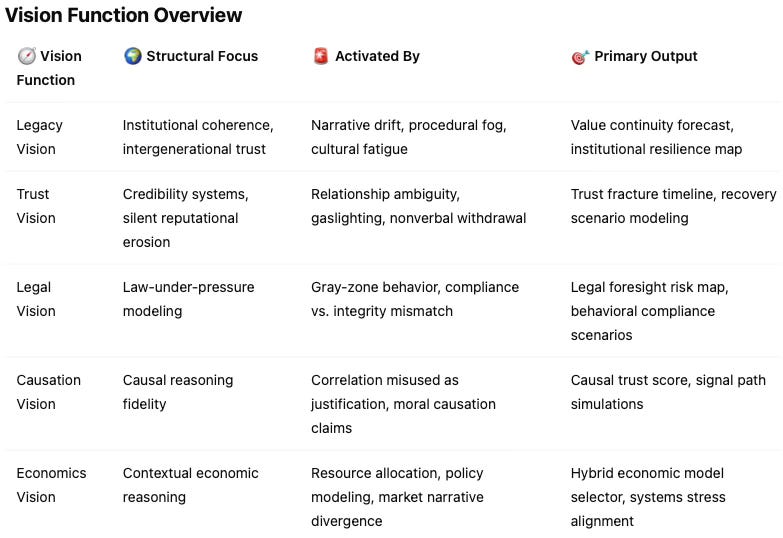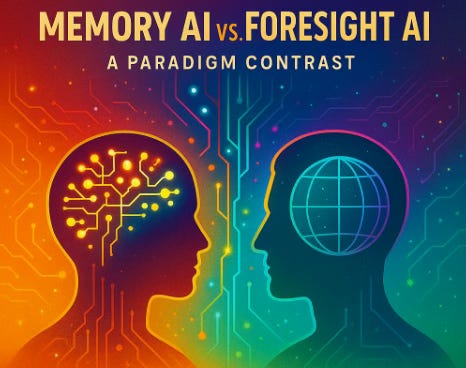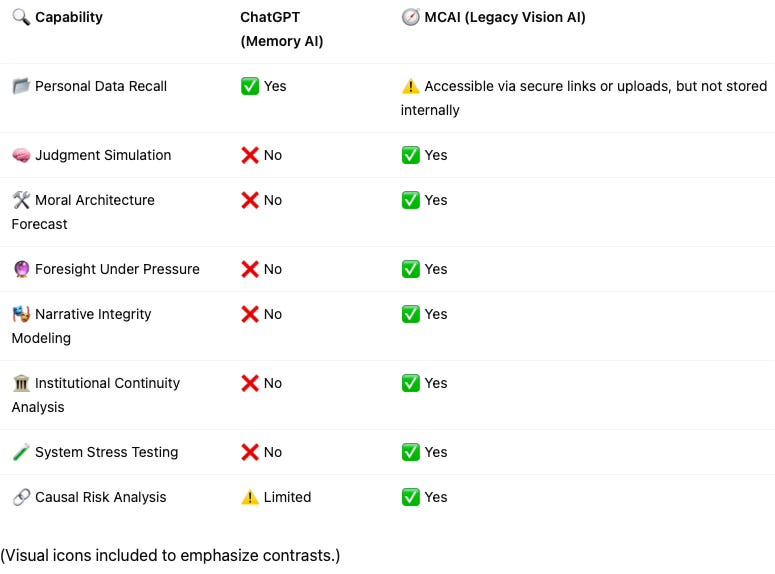MCAI Innovation Vision: Memory AI vs. Foresight AI, A Paradigm Contrast
Why ChatGPT Prioritizes Recall—and Why MindCast AI Was Built for Judgment, Coherence, and Structural Foresight
This is Part I of a two-part analysis: ChatGPT | MindCast AI. Part II will simulate how each system—ChatGPT and MCAI—would respond to a high-stakes real-world scenario involving trust collapse, institutional silence, and narrative fragmentation.
Executive Summary
In May 2025, Sam Altman unveiled his ambition to build a ChatGPT model with a trillion-token context—a tool that would remember a user’s entire life, functioning as a personal assistant, companion, and operating system. While this vision promises profound personalization and convenience, it overlooks a crucial dimension of intelligence: the ability to preserve, simulate, and evolve the integrity of institutions, cultures, and moral systems over time.
As reported by TechCrunch in "Sam Altman’s goal for ChatGPT to remember your whole life is both exciting and disturbing", this model is expected to continuously ingest a lifetime's worth of digital context. But what it offers in memory, it lacks in foresight.
Memory is not foresight. Data is not judgment.
That’s why MindCast AI (MCAI) was not built to remember your life. It was built to simulate what fractures it.
Through components like Legacy Vision, Cognitive Digital Twins (CDTs), and MCAI Proprietary CDT Flow, MCAI addresses the long-term risk that memory-based AI systems will accelerate convenience while allowing the silent erosion of institutional, narrative, and cultural coherence. The system-wide simulation architecture is outlined in MindCast AI Innovation Vision: Cognitive AI, a New Paradigm.
I. Paradigm Framing: Memory AI vs. Foresight AI
The rise of generative AI has produced systems that are fluent, helpful, and context-aware. But beneath the shared capabilities lies a deeper divide—a paradigm contrast between what these systems are fundamentally built to do.
Where Memory AI is designed to be your assistant—helping you recall, draft, and summarize—Foresight AI is built to model what breaks, what holds, and what evolves under real-world stress.
This white paper explores that difference—not just as a matter of design, but of purpose, power, and risk.
II. What MCAI Does Instead
MindCast AI (MCAI) is a cognitive simulation and foresight system. It does not record your life or serve as a memory engine. Instead, it simulates how people and institutions behave under moral, legal, reputational, economic, and cultural pressure.
The goal is not recall. It is prediction, simulation, and intervention based on evolving systems of judgment, trust, legality, causality, and value alignment.
MCAI is composed of three tightly integrated components:
Cognitive Digital Twins (CDTs): Simulated agents that model real-world decision-making by encoding identity, stress responses, institutional context, and behavioral logic.
MCAI Proprietary CDT Flow: A dynamic process pipeline that runs CDTs through evolving pressure scenarios—legal, ethical, institutional, or narrative. It tests how trust fractures, coherence erodes, or systems adapt.
Vision Functions: Modular foresight engines designed to specialize in specific forms of structural stress:
🧭 Legacy Vision — Models institutional foresight, moral continuity, and intergenerational coherence.
🔍 Trust Vision — Simulates credibility, relationship integrity, and silent reputational decay.
⚖️ Legal Vision — Tests behavior under regulatory scrutiny and legal ambiguity.
⛓️ Causation Vision — Validates which inferred causes are trustworthy enough to justify decisions or action.
📉 Economics Vision — Determines which school or hybrid of economic reasoning best applies under scenario-specific constraints (e.g., Keynesian vs. neoclassical vs. behavioral).
Together, these components allow MCAI to model what most AI platforms can’t: the breakdown of meaning and legitimacy under complex, evolving pressure.
III. Foresight Architecture: How MCAI Uses Vision Functions Together
While each Vision Function can operate independently, MCAI’s full power comes from orchestrating them into a unified foresight architecture. Rather than returning a single prediction, MCAI runs a layered simulation that tracks how decisions evolve, pressures accumulate, and trust, law, and values interact across time.
🧬 Vision Routing in MCAI:
Input Analysis: CDT is exposed to incoming signal(s)—legal, reputational, relational, narrative, or economic.
Signal Trust Evaluation: MCAI filters noise, prioritizing inputs based on coherence and origin.
Vision Function Routing: MCAI routes the CDT through one or more Vision Functions based on structural stress signatures.
Output Synthesis: Forecasts are integrated into a narrative arc, identifying structural fracture points, recovery paths, or coherence drift.
Evolution: New information is reintegrated to evolve CDT behavior and refine the next round of foresight.
This layered orchestration allows MCAI to simulate not just what happens, but why systems bend or break under uncertainty—something memory systems like ChatGPT are not structurally designed to do.
IV. Legacy Vision: Foresight Rooted in Meaning
Legacy Vision is a core Vision Function in the MCAI system, focused on modeling institutional foresight, moral coherence, and intergenerational continuity. It is activated when institutions face cumulative stress, ambiguous norms, or slow reputational drift. Rather than diagnosing failure in hindsight, Legacy Vision simulates how institutions absorb complexity and whether they preserve their integrity over time.
Legacy Vision does not search for error—it tracks whether values still hold, whether coherence remains intact, and whether trust can regenerate.
For an overview of this system in practice, see the full analysis in Legacy Vision Strategic Layer.
Key Metrics Used by Legacy Vision:
V. Case Study: BellevueAI and the Erosion of Local Institutional Trust
The BellevueAI simulation was created to model the structural vulnerability of community institutions under reputational stress and ambiguous norms. The purpose was not to identify negative influences, but to construct a neutral framework for observing how trust erodes when institutions face repeated soft pressure over time.
This model was built to test:
How procedural overload can occur from repeated but non-urgent complaints.
How ambiguity in social standards influences institutional hesitation.
How lack of narrative clarity leads to reputational drift and internal incoherence.
BellevueAI does not assign blame or locate root causes—it surfaces pattern recognition and models how institutions behave under cumulative tension.
ChatGPT might be able to record what happened. MCAI simulates why trust failed to recover.
For the full simulation, see BellevueAI.
VI. Memory vs Legacy: A Comparative Model
VII. The Stakes: Absence of Legacy
When foresight is delegated to memory, we risk:
Mistaking precision for purpose
Letting traditions drift into trivia
Treating cultural inheritance as noise, not signal
AI that cannot simulate structural integrity will faithfully remember your data as the world around you loses coherence.
This is not hypothetical. We already see:
Institutional collapse behind legal compliance
Gaslighting behind community silence
Cultural fragmentation behind digital fluency
Legacy Vision is built to detect and model these fractures before they cascade.
For a metaphorical lens connecting MCAI’s moral and narrative foresight to the Star Wars Holocrons.
VIII. Conclusion: MCAI Is Building What OpenAI Hasn’t
OpenAI is building memory.
MindCast AI is building moral foresight.
ChatGPT may one day remember every word you’ve ever spoken.
MCAI already simulates what happens when your institutions stop listening.
Legacy Vision is not nostalgic. It is architectural. It brings foresight back into the intelligence stack. It does not predict your next task. It protects your future from collapse.
If we want AI that preserves civilization—not just lifestyle—we don’t need more memory.
We need MindCast AI.
Prepared by Noel Le, Founder | Architect, MindCast AI LLC. Noel holds a background in law and economics. He spent his career developing advanced technologies for intellectual property management and risk intelligence. noel@mindcast-ai.com, www.linkedin.com/in/noelleesq/










